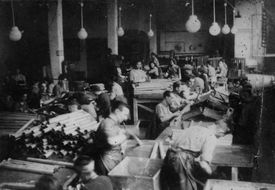NS Forced Labour at the "Hugo-Schneider-Aktiengesellschaft" Company
The “Hugo-Schneider-Aktiengesellschaft” (HASAG) was the biggest arms company of Saxony and one of the main ‘beneficiaries’ of NS forced labour during World War II. The company owned large ammunitions factories in the German Reich and in the occupied Poland, at which they exploited thousands of Jewish men and women, civilian forced labourers and internees of concentration camps.
The company was originally founded as a manufacturer of lamps and metal goods in Leipzig in 1863 and expanded rapidly. After 1933, HASAG switched to producing armaments and developed the “Panzerfaust” (an anti-tank warhead), one of the most important weapons of the Wehrmacht.
From 1939 onwards, growing numbers of foreign forced labourers were made to work in production at the company’s factories. At the Leipzig headquarters alone, more than 10,000 civilian forced labourers, prisoners of war and internees of concentration camps from all over Europe had to produce ammunition and anti-tank warheads in appalling working and living conditions during World War II. They were housed in large camps in the immediate vicinity of the factory grounds.
In the summer of 1944, the largest women’s subcamp of Buchenwald concentration camp was established next to the factory grounds, housing over 5,000 female internees. During the following months, further subcamps were also created at HASAG’s other production sites: Taucha, Altenburg, Meuselwitz, Schlieben, Colditz and Flößberg.
On 13 April 1945, the women’s subcamp in Leipzig was cleared and the internees were sent on a death march. After the end of the war, the Leipzig factory came under Allied control and was demolished with the exception of the main building.
